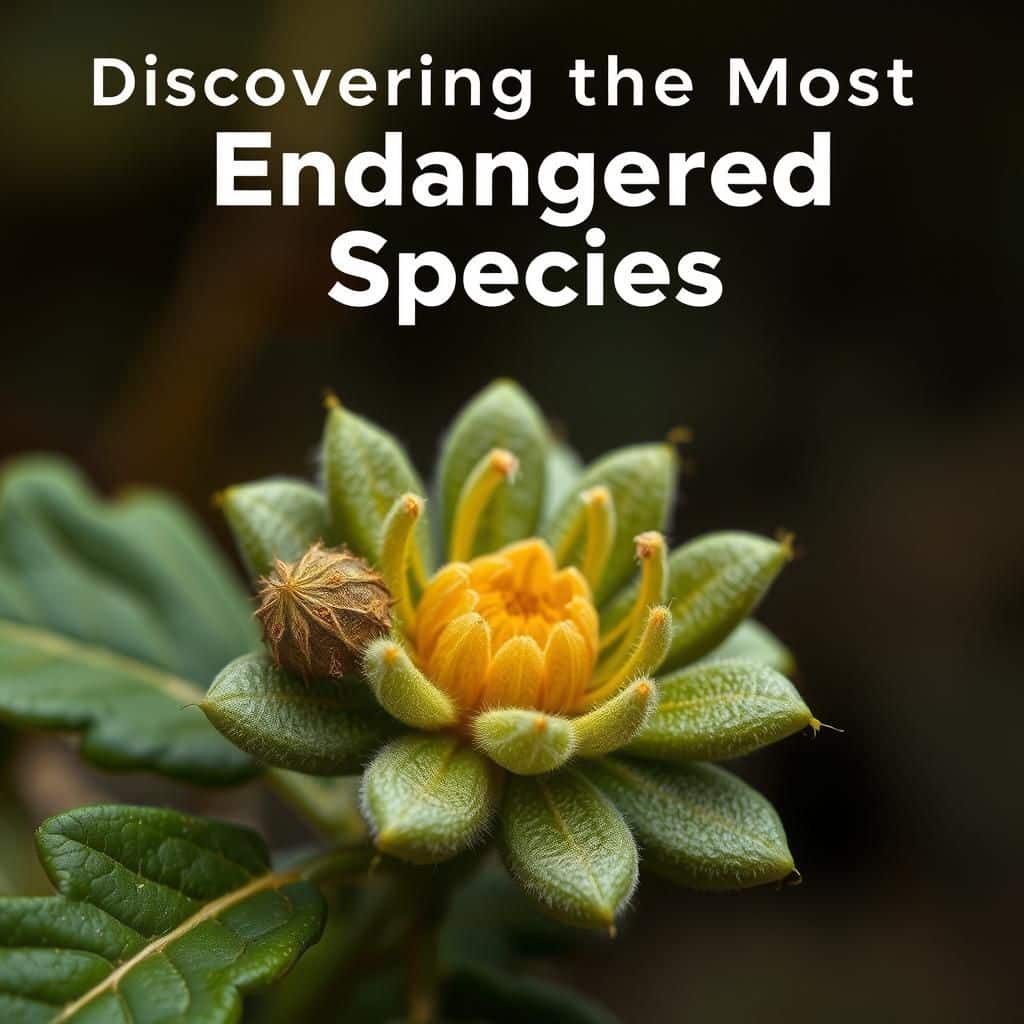Discovering the Most Endangered Species: Threatened Plants in Australia

Australia is home to a diverse range of flora, but many of its plant species are facing critical threats that push them towards extinction. This article delves into the most endangered plants in Australia, exploring the factors that endanger their survival, such as habitat loss, climate change, and invasive species. By highlighting these vulnerable species, we aim to raise awareness about the urgent need for conservation efforts. Understanding the plight of these plants is crucial, not only for biodiversity but also for the health of ecosystems that rely on them. Join us as we uncover the hidden treasures at risk beneath Australia's unique landscapes.
Threatened Plants in Australia
Australia is home to an incredible diversity of flora, but many species are now considered threatened due to factors such as habitat destruction, climate change, and invasive species. The unique environment of Australia supports a variety of ecosystems, but the pressure from urban development, agriculture, and mining activities has led to significant declines in plant populations. Conservation efforts are crucial to protect these endangered species, which are vital for maintaining the ecological balance and supporting wildlife that depend on them for survival.
Key Factors Contributing to Threatened Status
The primary contributors to the threatened status of plants in Australia include habitat loss, invasive species, and climate change. Urbanization and agricultural expansion have resulted in the destruction of natural habitats, while invasive species often outcompete native plants for resources. Additionally, changing climate conditions can alter ecosystems, making it difficult for some plant species to survive. Addressing these issues is essential for the preservation of Australia's unique plant life.
Significant Threatened Plant Species
Several plant species in Australia are recognized as endangered or vulnerable. For instance, the Western Australian Christmas Tree (Nuytsia floribunda) is impacted by habitat destruction, whereas the Coral Fern (Gleichenia spp.) faces threats from changing water levels and invasive plants. These species play crucial roles in their ecosystems, and their decline can have far-reaching effects on biodiversity. Protection measures and rehabilitation strategies are necessary to ensure their survival.
Conservation Efforts in Australia
In response to the alarming decline in threatened plant species, various conservation efforts have been implemented across Australia. This includes the establishment of protected areas, funding for rehabilitation projects, and public awareness campaigns. Advocacy groups and government agencies collaborate to create effective policies that prioritize the conservation of biodiversity. Monitoring programs are also in place to track the health of native plant populations and the success of conservation initiatives.
See also:
The Role of Indigenous Knowledge
Indigenous knowledge plays a vital role in the conservation of threatened plants in Australia. Indigenous communities have long-standing relationships with the land and possess invaluable insights into sustainable practices. Collaborating with these communities can enhance conservation strategies by integrating traditional ecological knowledge, which may include techniques for managing land and preserving biodiversity. Such partnerships can foster better outcomes for threatened plant species.
Future Outlook for Threatened Plants
The future of threatened plants in Australia depends on concerted conservation efforts and public engagement. With ongoing challenges such as climate change and urban development, it is crucial to prioritize research and funding for plant conservation. Raising awareness about the importance of protecting endemic species can encourage community involvement and support for conservation initiatives. The engagement of various stakeholders—governments, organizations, and local communities—is essential for creating a sustainable future for Australia's flora.
| Threatened Species | Status | Main Threats |
|---|---|---|
| Western Australian Christmas Tree | Endangered | Habitat destruction |
| Coral Fern | Vulnerable | Invasive plants, water level changes |
| Wollemi Pine | Critically Endangered | Climate change, fire |
| St Helena Island Orchid | Endangered | Urbanization, habitat loss |
| Spiny Toadflax | Vulnerable | Invasive species, land clearing |
Understanding the Causes of Endangerment for Australia's Unique Plant Species
The endangerment of Australia's unique plant species is primarily attributed to several interconnected factors. Habitat loss, driven by urbanization, agriculture, and deforestation, has significantly reduced the natural environments where many native species thrive. Invasive species further complicate this issue, as they compete for resources and often outcompete local flora. Additionally, climate change poses a growing threat, altering weather patterns and affecting water availability, which is crucial for the survival of many plant species. These combined pressures have led to an alarming number of plants facing the risk of extinction, underscoring the need for immediate conservation efforts.
The Role of Invasive Species in Plant Endangerment
Invasive species play a pivotal role in the endangerment of native plants in Australia. These non-native species, introduced either accidentally or intentionally, can alter ecosystems by outcompeting local flora for resources such as light, nutrients, and water. They can also introduce new diseases that local species are ill-equipped to handle. For instance, the presence of invasive grasses can change fire regimes, making it harder for native plants to survive. Understanding the impact of these invaders is critical for developing effective management strategies to protect vulnerable species.
Climate Change Effects on Australia's Flora
Climate change is increasingly affecting the diverse flora of Australia, leading to shifts in species distribution and the timing of biological events. Altered rainfall patterns result in droughts or flooding, placing additional stress on plants that have evolved under specific climatic conditions. Moreover, rising temperatures can exacerbate the vulnerability of already rare species, potentially pushing them towards extinction. In response, conservationists are focused on understanding adaptive strategies that plants might utilize to survive in this rapidly changing environment.
See also:
The Importance of Conservation Efforts
Conservation efforts for threatened plant species in Australia are essential not only for biodiversity but also for maintaining ecosystem services that benefit human populations. Initiatives such as habitat restoration, creation of protected areas, and ex-situ conservation (such as seed banks) play a critical role in safeguarding these plants for future generations. Collaborative efforts involving government agencies, non-profit organizations, and local communities are crucial for implementing successful conservation strategies that address the multifaceted threats these species face.
Legislation and Policy for Plant Protection
Effective legislation and policy are vital to the protection of endangered plant species in Australia. The Environment Protection and Biodiversity Conservation Act (EPBC Act) establishes a framework for the conservation of threatened species and their habitats. This legal framework allows for conservation actions such as listing endangered species, which can trigger funding and protections to mitigate threats. However, successful implementation relies on ongoing research and community involvement to ensure that policies are effective and reflect the needs of both the plants and the ecosystems they inhabit.
The Role of Education in Conservation Awareness
Education plays a fundamental role in raising awareness about the importance of conserving Australia’s threatened plant species. Public knowledge about the threats these plants face and the need for conservation can lead to increased support for conservation initiatives and policies. Educational programs in schools and community organizations promote understanding of biodiversity and the ecological roles that different plant species play. By fostering a sense of stewardship, communities can engage in local conservation efforts, contributing to the protection of their natural heritage.
Questions from Our Readers
What are some examples of threatened plants in Australia?
Some examples of threatened plants in Australia include the Western Australian Carnaby’s Black Cockatoo, which relies on certain native Banksia species for food, and the Bidgee-widgee, a small shrub that is endangered due to habitat loss. These plants are critical to the ecosystem and their decline can impact various wildlife species.
What are the main reasons for plant endangerment in Australia?
The main reasons for plant endangerment in Australia are habitat destruction, invasive species, climate change, and urban development. These factors contribute to the loss of suitable environments for many native plants, resulting in a decline in their population numbers and overall biodiversity.
See also:
How can individuals help protect threatened plants in Australia?
Individuals can help protect threatened plants in Australia by supporting conservation initiatives, participating in local restoration projects, and being mindful of their ecological footprint. Educating others about the importance of these plants and their roles in the environment can also foster a collective effort towards preservation.
What regulations exist to protect threatened plants in Australia?
Australia has various regulations in place to protect threatened plants, including the Environment Protection and Biodiversity Conservation Act (EPBC Act), which aims to prevent further decline and promote recovery plans. This legislation provides a framework for the protection of endangered species and their habitats across the country.

If you want to read more articles like Discovering the Most Endangered Species: Threatened Plants in Australia, we recommend you check out our Landscaping category.
Leave a Reply
Related Articles